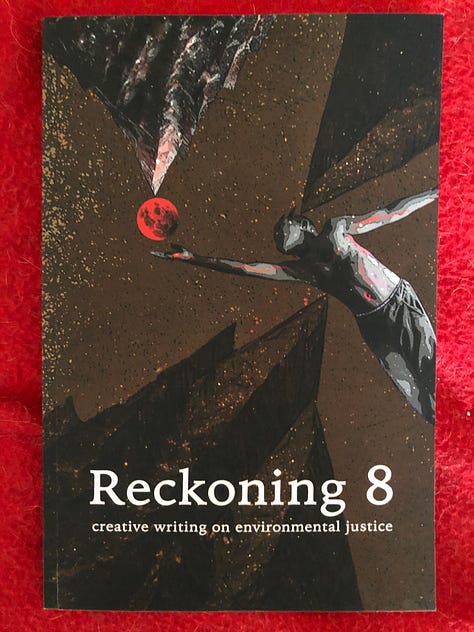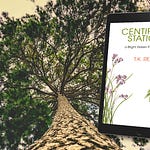Hello Friends!
Welcome to Bright Green Futures, Episode Eighteen: The Power of Hope
I created Bright Green Futures to lift up stories about a more sustainable and just world and talk about the struggle to get there.
This episode, we’re going to talk about the four kinds of hope and how to understand the surge in hope and joy that’s happening in this political moment we’re having in America.
Joy and Hope Everywhere
I’ve been a big believer in hope long before this wave of joy and hopefulness that’s come from the sudden change in the presidential ticket to Harris/Walz. In this moment, the words “joy” and “hope” are everywhere, and completely without the usual sneering and scoffing. I shared this meme:
I also shared this comic:
It feels good, and shows no signs of slowing down.
I’ll admit it’s a bit of a strange feeling to have been cheerleading hope for a long time and then suddenly to have everyone around you start cheering too.
What is even happening here?
Hard times make despair and cynicism easy, and we’ve had no lack of hard times for a lot of years. And all along, the peddlers of hate and fear have been openly championing the worst traits of humanity: bigotry, cruelty as the point, meanness portrayed as a virtue, and vulgarity that has nothing to do with the word fuck and everything to do with being the worst sort of human. We’ve been starved for open goodness, pure wholesomeness, and any kind of firm declaration that the right way to exist in the world is through kindness and compassion and love. What we crave is the affirmation that joy and hope are, in fact, essential parts of being fully human in the world. That goodness is, in short, good.
And that it’s not cheesy or silly or childish to say so, which is what all the cynics and hate scolds like to say. Hope and joy are, in fact, radical and subversive, a direct rebuttal to the brutality of the world.
I’ve been saying this for a long time.
Hope’s Steady Defender
So has Rebecca Solnit, champion of weaponizing compassion and hope as an action. She recently shared a post of hers from 2016 that referred to the publication of her book, Hope in the Dark, back in 2004.
Four years ago was 2020, when I started publishing my solarpunk novel series. I’d actually been writing hopepunk since at least 2017, but in 2020, I took that public, actively championing hopepunk with stories, posts, library and conference panels, and an article in DreamForge Magazine titled, Rewriting the Future. And of course more and more stories since then, and eventually a podcast.
Along the way, I discovered we have a very complicated relationship with the word hope — it has many different meanings, it is very context dependent, and it’s often weaponized in the bad way (to actually kill hope) rather than the good way (to sustain it and lead to action).
In general, and as we’re seeing viscerally now in the political landscape in America, the thing fascists fear most is hope. They have no idea how to cope with joyful, loving, and compassionate people. None. It is absolutely outside their universe and at the same time, a direct rebuttal of it.
This is the radical nature of hope. It is antifa in the most elemental way.
But it’s difficult to sustain the belief in this—the belief that we’re capable of being this way in the world—when things are hard. And friends, I hope you understand I say this with love, but there are going to be some really hard times ahead. We need to get good at weaponizing this hope thing, which is why I’m gonna do deep dive into the four kinds of hope and how understanding the different types can help us sustain it. And maybe put to bed some of the fears in some corners that hope leads to complacency, when of course, it does just the opposite.
I hope it’s obvious how all this relates to hopeful climate fiction, but to be blunt: the stories we tell ourselves about the possibility of hope are literally what makes it possible.
Four Kinds of Hope
Back in 2020, I stumbled across an academic presentation at a climate conference by then-PhD student Jasmin Kirkbride where she examined the roles 4 kinds of hope played in fiction and climate activism:
4 Kinds of HOPE:
Hope as deceiver—wishful thinking, false hope
Hope as object—external, “best we can hope for”—better term is “optimism”
Hope as sustainer—trying to keep hope alive despite depressing reality
Hope as catalyst—individual and communal action—“realistic hope”
The first two—deceptive hope and optimistic hope—are essentially passive. The wishful thinking that things will just “work out” or that there’s nothing to be done but “hope for the best” are disempowering versions of the word. The people who mock hope are saying all versions of hope are this passive thing that only the ridiculous or the childish would believe in. What they’re really doing, however, is trying to destroy the two active forms of hope—sustaining hope and catalyzing hope. Ironically, those who mock hope the hardest are often arguing for passivity themselves with a very strong commitment to their despair and that nothing can be done. You’ll hear the echoes of this in any argument that says some action—voting, speaking out, protests, literally any action working for change—is “pointless.”
They—the cynics and doomers—are “just being realistic” unlike you silly dreamers who believe in utopias or naive children who think everything will be just fine on its own. Scratch a little deeper and these folks are often one step away from justifying violence as “the only answer.”
But it’s hard to justify violence when there are other options.
Sustaining hope and catalyzing hope offer those other options, so let’s unpack those a little.
Sustaining hope is the kind that gets you through when you can’t see the actual pathway—the lights are off, darkness has descended upon the world, and none of the flashlights are working. Or the future is literally unknowable, as the future always is. So you feel your way forward, moving on faith in the process, focusing on actions that are good regardless of whether they “work”: these actions support core human values, things like compassion, kindness, caring works, feeding people, working for justice and equal rights. Throughout history, at all times and in every movement, this kind of sustaining hope is what moved people. Activists don’t take the actions they do because they think the outcome is guaranteed—they hope to win the right to gay marriage but, more importantly, they know it’s worth working for, regardless.
One of my favorite quotes on sustaining hope comes from Václav Havel, Czech dissident, writer and statesman: “Hope is not the conviction that something will turn out well, but the certainty that something is worth doing no matter how it turns out.”
Another word for that is belief or faith—not of the religious kind but in something bigger than yourself. I have a sustaining hope in the power of story. I have a belief that radical compassion and kindness are better, more human, more sustainable ways of being. I have faith that people can work together and when they do, that there’s no problem they cannot solve and no force on earth that can stop them. That sustaining hope is what I put into action every day.
Catalyzing hope, by contrast, is the hope you have when you can see the way out. There’s a light at the end of the tunnel, something has changed and possibilities have opened up, or you simply learn some new piece of information or hear a story that feels true, and suddenly, you feel that surge of catalyzing hope—the kind that gets you moving, taking action because you think the chances of it working out have suddenly increased. This will work, you think, and if there’s one thing psychology has taught us, it’s that humans are motivated when they think something that they want is within reach and the likelihood of reaching it is high. Catalyzing hope is what we’re seeing right now with the US Presidential election. People see the possibility of change as more real now. They can see the pathway forward, so now they’re ready to come together, work together, organize and move forward together.
There’s no point in me saying “you could have done that before” because the truth is that many people can’t — unless they see the pathway forward, they will stand in the dark and despair. For many people, catalyzing hope is the only kind of hope they can access. They don’t have the faith or belief that we’re capable of this — that at any moment we can decide to organize, be compassionate, work together. They might believe that for themselves, but they have no faith in the rest of humanity. Sustaining hope does not work for them because they cannot see it.
And part of the reason they can’t possibly imagine it working, is that all our stories have, on repeat, forever, shown them nothing but darkness and conflict.
Which is why I write these hopeful climate fiction stories—so folks can see what this actually looks like. So they can access that catalyzing hope that will spur them to action. Or maybe, just maybe, I can tell a story so true, one that resonates so deeply, that it reminds you of the faith you once had. The belief that we are capable of this, of caring, of working together.
This slow work, this storytelling work, this movement building work, is important to make the future visible for people. It’s the foundation upon which an explosion of hope due to a change in circumstances can catalyze real change.
My friends, we have more hard times ahead. The climate will worsen. The future is made of precarity and unpredictability—which is why we need to build systems of resilience now, so we can weather the literal storms, and the political and economic ones, that are come. Resilience is what gets us through because we can’t predict the future or rely on passive hope.
What we need are a lot of folks who can envision a better future and work actively to make it happen.
It’s my fervent sustaining hope that today’s surge of catalyzing hope will get us to a better place and will reaffirm that belief in the possibility of a better tomorrow.
Kirkbride said in her presentation that hopepunk stories focus on hope as a sustainer and a catalyst—that it transgresses the line between fiction and reality to manifest hope in its readers.
I certainly hope so.
As a parting note, I dredged up this post from January 6th, 2021.
I wrote this post in that shining moment between when we won the Georgia runoff, and thus secured a Senate majority, and before the insurrection just minutes later.
We had more hard times ahead… but I wasn’t wrong.
The insurrection failed, democracy held, and we had a peaceful transfer of power.
And the work, from that moment forward, was all about charting a new path and making it happen.
Sustaining hope when we can’t see the path forward.
Catalyzing hope when we can.
Let’s get to work.
Bright Green Futures is a weekly newsletter/podcast. Check out the Featured Stories and Hopeful Climate Fiction lists for further reading. The best way to support the show is to subscribe and share the stories with your friends.
LINKS Ep. 18: The Power of Hope
Hope in the Dark by Rebecca Solnit
Rewriting the Future (Susan Kaye Quinn, DreamForge Magazine)
Sue’s website: explainer on hopepunk/solarpunk, short fiction, and novels
PLEASE SHARE
Tiktok, Facebook, Mastodon, Instagram, Threads
Make sure to enter August’s giveaway!























Share this post